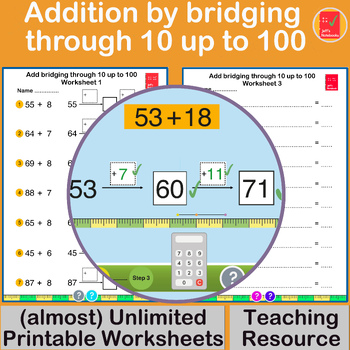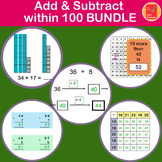Add by bridging through 10 up to 100
- Zip
- Easel Assessment
Also included in
- Bridging through 10 is a mental math technique that breaks down addition or subtraction into 3 simple steps to get to the final answer. Students apply and/or strengthen their knowledge of number bonds to 10 and therefore extend their skills at mental addition and subtraction with numbers up to 100.Price $7.50Original Price $10.00Save $2.50
- Adding and Subtracting within 100 - 1st GradeAn almost unlimited source of no-prep Worksheets, supported by Digital Teaching Material and Easel assessments covering Adding and Subtracting within 100 with and without visual support These are aimed at a number of 1st Grade Common Core Standards, but aPrice $29.50Original Price $42.00Save $12.50
Description
Bridging through 10 is a mental math technique that can be used when adding two numbers with 'units' that have a sum greater than ten. Students apply and/or strengthen their knowledge of number bonds to 10 and therefore extend their skills at mental addition to numbers up to 100
This pack has 3 parts
1. Worksheet Sets
Worksheet Set 1
Adding 1 digit numbers to 2 digit numbers, bridging up to 100 - with visual support
Worksheet Set 2
Adding 2 digit numbers to 2 digit numbers, bridging up to 100 - with visual support
Pupils have the opportunity to practice this topic further either by using the visual method from Worksheets 1 & 2, or using their own graphics that support the concept of bridging.
Worksheet Set 3
Adding 1 digit numbers to 2 digit numbers, bridging up to 100.
Worksheet Set 4
Adding 2 digit numbers to 2 digit numbers, bridging up to 100.
How many worksheets are in each set ?
Almost Unlimited. At the click of a button all numbers are randomised, so you can create as many different worksheets as you need for classwork, homework, revision, preparing for assessment, fillers etc and the numbers will change every time.
Answers are automatically generated every time.
Download the Preview File to see a sample Worksheet and full details of the pack.
2. The "Interactive Teaching Resource" is designed to be used by teachers and pupils on an Interactive Whiteboard or on a PC/Mac computer for one-to-one tuition. Examples are randomly generated at the click of a button, so you can use this one page as many times as needed. There is also the option to take the pupils through the process in 3 separate steps, one at a time.
3. The "Easel Assessment" consists of 10 multiple choice questions where the pupil must select one option that has the correct final answer AND all the correct numbers at each stage as on the Worksheet Sets 1 & 2.
Note
These resources work with the official Adobe Acrobat Reader on Windows or Mac computers.








